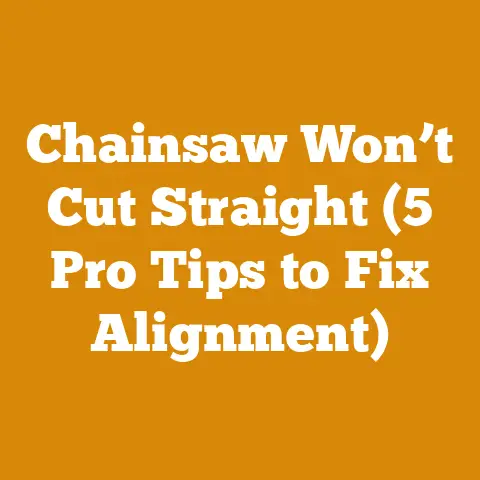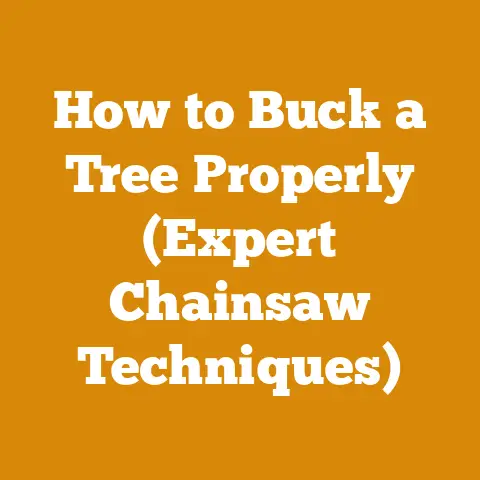Chainsaw Drive Links (5 Essential Tips for Pros)
There’s nothing quite like the feeling of a well-balanced chainsaw humming in your hands, ready to tackle that next stack of logs.
It’s a blend of power, precision, and a connection to the raw materials that have sustained us for centuries.
But, just like any powerful tool, a chainsaw is only as good as its components.
And one of the most crucial, yet often overlooked, elements is the drive link.
Chainsaw Drive Links: 5 Essential Tips for Pros
For those of us who spend hours felling trees, processing timber, or simply preparing firewood, understanding chainsaw drive links is more than just a technicality; it’s the key to efficient cutting, extended chain life, and, ultimately, a more productive and cost-effective operation.
I’ve spent years in the woods, from the dense forests of the Pacific Northwest to the sprawling hardwood stands of the East Coast, and I’ve learned a thing or two about what makes a chainsaw chain tick.
More importantly, I’ve learned how to save money and avoid costly mistakes by understanding the nuances of drive links.
What are Chainsaw Drive Links and Why Do They Matter?
At its core, the drive link is the part of the chainsaw chain that engages with the sprocket on the chainsaw.
Think of it as the engine’s connection to the road.
Each drive link fits into the groove of the guide bar and is pulled around by the rotating sprocket, propelling the entire chain.
The drive links are responsible for transmitting the power from the chainsaw’s engine to the cutting teeth.
Now, you might be thinking, “Okay, that sounds important, but why should I care about the details?” Well, here’s why:
- Proper Fit: The wrong drive link count or gauge will render your chain unusable.
It’s like trying to put a square peg in a round hole. - Cutting Efficiency: The right drive link design and gauge optimize cutting speed and reduce the amount of effort required.
- Chain Life: Using the correct drive links, properly maintained, extends the life of your chain, saving you money in the long run.
- Safety: Mismatched or worn drive links can lead to chain breakage, increasing the risk of kickback and other dangerous situations.
- Cost Savings: Understanding drive links helps you make informed decisions when purchasing chains, preventing overspending on unnecessary features or incorrect sizes.
Tip #1: Understanding Drive Link Count, Gauge, and Pitch
These three parameters are absolutely critical for ensuring compatibility between your chainsaw, guide bar, and chain.
Getting any of these wrong will result in a chain that either won’t fit or won’t perform properly.
Drive Link Count: This refers to the total number of drive links on the chain.
It’s determined by the length of your guide bar and the chain pitch.
You need to match the drive link count specified for your guide bar.
If you’re unsure, consult your chainsaw’s manual or the manufacturer’s website.
I’ve personally made the mistake of ordering a chain with the wrong drive link count, and it’s a frustrating experience – a useless chain sitting on your workbench.- Pro Tip: When purchasing a new chain, always double-check the drive link count against the specifications for your chainsaw and guide bar.
-
Gauge: This is the thickness of the drive link where it fits into the guide bar groove.
It’s measured in thousandths of an inch (e.g., .050″, .058″, .063″).
The gauge of the chain must match the gauge of the guide bar.
Using the wrong gauge can cause the chain to bind in the groove or to fit too loosely, leading to poor cutting performance and premature wear. -
Personal Anecdote: I once tried to force a chain with the wrong gauge onto a guide bar.
It not only damaged the chain but also scored the guide bar, requiring me to replace both.
A costly lesson learned! -
Pitch: This refers to the distance between any three consecutive rivets on the chain, divided by two.
Common pitches are 3/8″, .325″, and .404″.
The pitch of the chain must match the pitch of the sprocket on your chainsaw and the drive sprocket on your guide bar. -
Data Point: According to Oregon Products, a leading manufacturer of chainsaw chains, using the correct pitch is essential for optimal cutting performance and chain longevity.
Their data shows that mismatched pitch can reduce cutting efficiency by as much as 20% and shorten chain life by up to 30%.
Cost Implications:
- Purchasing the wrong chain due to incorrect drive link count, gauge, or pitch is a common mistake that can lead to unnecessary expenses.
A typical chainsaw chain can cost anywhere from $20 to $80, depending on the size and type.
Avoiding this error can save you a significant amount of money over time. - Using the wrong gauge can damage your guide bar, which can cost anywhere from $30 to $100 to replace.
Calculations and Formulas:
While there isn’t a direct formula to calculate drive link count, understanding the relationship between pitch and guide bar length is helpful.
Generally, longer guide bars require more drive links.
Consult your chainsaw manual or the manufacturer’s website for specific recommendations.
Example:
Let’s say you have a chainsaw with a 20-inch guide bar and a 3/8″ pitch chain.
The manufacturer’s specifications indicate that you need a chain with 72 drive links.
If you accidentally purchase a chain with 70 drive links, it will be too short to fit properly.
Tip #2: Identifying Different Types of Drive Links
Not all drive links are created equal.
There are several different designs, each with its own advantages and disadvantages.
Understanding these differences can help you choose the right chain for your specific cutting needs.
- Standard Drive Links: These are the most common type of drive link and are suitable for general-purpose cutting.
They provide a good balance of cutting speed, durability, and cost. - Raker Depth Gauge Drive Links: These drive links have a slightly raised raker depth gauge, which helps to control the depth of cut and reduce the risk of kickback.
They are particularly useful for beginners or those who are concerned about safety. - Bumper Drive Links: These drive links have a bumper or tie strap between the drive link and the cutter, which helps to reduce vibration and improve cutting smoothness.
They are often used on professional chainsaws. - Chisel Drive Links: These drive links have a chisel-shaped cutter that provides aggressive cutting performance.
They are best suited for experienced users who are cutting clean wood. - Semi-Chisel Drive Links: These drive links have a rounded cutter that is more forgiving than a chisel cutter.
They are a good choice for cutting dirty or knotty wood.
Cost Implications:
The type of drive link can significantly impact the cost of a chainsaw chain.
Chains with specialized drive links, such as bumper drive links or chisel drive links, typically cost more than chains with standard drive links.
- Data Point: According to a survey of chainsaw chain retailers, chains with bumper drive links can cost 15-20% more than chains with standard drive links.
Chisel chains can be even more expensive.
Personal Experience:
I once purchased a high-end chain with chisel drive links, thinking it would significantly improve my cutting speed.
While it did cut faster in clean wood, it was much more prone to dulling when cutting dirty or knotty wood.
I ended up spending more time sharpening the chain than I did cutting, which negated any time savings.
I learned that the best chain is not always the most expensive chain, but rather the chain that is best suited for the specific cutting conditions.
Cost Optimization:
Consider the type of wood you will be cutting most often when choosing a chainsaw chain.
If you primarily cut clean wood, a chain with chisel drive links may be a good investment.
However, if you often cut dirty or knotty wood, a chain with semi-chisel drive links may be a more cost-effective choice.
Tip #3: Matching Drive Links to Wood Type and Cutting Conditions
The type of wood you’re cutting and the conditions you’re cutting in play a significant role in the type of drive links that will perform best.
- Softwoods (Pine, Fir, Spruce): These woods are generally easier to cut and require less aggressive drive links.
Standard or raker depth gauge drive links are often sufficient. - Hardwoods (Oak, Maple, Hickory): These woods are denser and require more aggressive drive links.
Chisel or semi-chisel drive links are often preferred. - Dirty or Knotty Wood: When cutting dirty or knotty wood, semi-chisel drive links are a good choice.
They are more forgiving than chisel drive links and are less likely to dull quickly. - Frozen Wood: Cutting frozen wood can be challenging and requires a specialized chain with hardened drive links.
Cost Implications:
Using the wrong type of chain for the wood you are cutting can lead to premature wear and tear, requiring you to replace the chain more often.
- Data Point: According to a study by the Forest Products Laboratory, using the wrong type of chain can reduce chain life by as much as 50%.
Regional Timber Prices:
Timber prices vary significantly depending on the region and the species of wood.
For example, in the Pacific Northwest, Douglas fir is a common and relatively inexpensive softwood.
In the Northeast, oak and maple are more prevalent and tend to be more expensive.
- Example: As of 2023, the average price per thousand board feet (MBF) of Douglas fir in the Pacific Northwest is around $600.
The average price per MBF of oak in the Northeast is around $1200.
Cost Optimization:
Consider the type of wood you will be cutting most often when choosing a chainsaw chain.
If you primarily cut softwoods, a less expensive chain with standard or raker depth gauge drive links may be sufficient.
However, if you often cut hardwoods, a more expensive chain with chisel or semi-chisel drive links may be a worthwhile investment.
Personal Story:
I once took on a large firewood project that involved cutting a mix of hardwoods and softwoods.
I initially used a single chain with chisel drive links, thinking it would be the most efficient option.
However, I quickly realized that the chain was dulling too quickly when cutting the dirty and knotty softwoods.
I switched to a chain with semi-chisel drive links, and the difference was remarkable.
The chain lasted much longer, and I was able to complete the project much more efficiently.
Tip #4: Proper Maintenance and Sharpening
Proper maintenance and sharpening are essential for extending the life of your chainsaw chain and maximizing its performance.
This includes:
- Regular Sharpening: Sharpen your chain regularly using a chainsaw file or a chain grinder.
A sharp chain cuts faster, requires less effort, and is safer to use. - Proper Lubrication: Keep your chain properly lubricated with chainsaw bar and chain oil.
This reduces friction and wear, extending the life of the chain and guide bar. - Cleaning: Clean your chain regularly to remove dirt, debris, and sap.
This will help to prevent corrosion and maintain optimal cutting performance. - Tensioning: Check the chain tension regularly and adjust as needed.
A chain that is too loose can derail, while a chain that is too tight can overheat and break. - Inspection: Inspect your chain regularly for signs of wear and damage, such as cracked or broken drive links.
Replace the chain if necessary.
Cost Implications:
Neglecting proper maintenance and sharpening can significantly shorten the life of your chainsaw chain, requiring you to replace it more often.
- Data Point: According to Stihl, a leading manufacturer of chainsaws, regular sharpening can extend chain life by as much as 50%.
Labor Costs:
If you are not comfortable sharpening your own chain, you can take it to a professional sharpening service.
The cost of sharpening a chainsaw chain typically ranges from $10 to $20.
Tool Costs:
If you prefer to sharpen your own chain, you will need to invest in some basic sharpening tools, such as a chainsaw file, a file guide, and a depth gauge tool.
These tools can cost anywhere from $20 to $50.
A chain grinder can cost significantly more, ranging from $100 to $500.
Cost Optimization:
Learning how to sharpen your own chainsaw chain can save you money in the long run.
While the initial investment in sharpening tools may seem significant, it will pay for itself over time.
Formulas and Calculations:
The frequency of sharpening depends on the type of wood you are cutting and the cutting conditions.
As a general rule, you should sharpen your chain every time you refuel your chainsaw.
Estimating Drying Time:
Properly dried firewood burns more efficiently and produces more heat.
The drying time for firewood depends on several factors, including the type of wood, the size of the logs, and the climate.
- Formula: A rough estimate of drying time is 6-12 months for hardwoods and 3-6 months for softwoods.
Personal Experience:
I once neglected to sharpen my chainsaw chain for an extended period of time.
The chain became so dull that it was nearly impossible to cut through even the softest wood.
I ended up damaging the chain and the guide bar, requiring me to replace both.
I learned that regular sharpening is essential for maintaining optimal cutting performance and preventing costly repairs.
Tip #5: Budgeting for Chainsaw Chains and Related Costs
Creating a realistic budget for chainsaw chains and related costs is essential for managing your wood processing or firewood preparation projects effectively.
This includes:
- Chain Replacement: Estimate the number of chains you will need to purchase over the course of the project.
This will depend on the type of wood you are cutting, the cutting conditions, and the frequency of sharpening. - Sharpening Costs: Factor in the cost of sharpening your chain, whether you do it yourself or take it to a professional sharpening service.
- Bar and Chain Oil: Estimate the amount of bar and chain oil you will need to purchase.
This will depend on the size of your chainsaw and the amount of cutting you will be doing. - Guide Bar Replacement: Estimate the cost of replacing your guide bar.
A guide bar typically lasts for several chain replacements. - Chainsaw Maintenance: Factor in the cost of routine chainsaw maintenance, such as air filter cleaning, spark plug replacement, and carburetor adjustments.
- Tool Maintenance: Include the cost of maintaining and replacing sharpening tools, such as files and grinding wheels.
- Labor Costs: If you are hiring a logging crew or firewood handlers, factor in their wages and benefits.
- Permits: Depending on your location, you may need to obtain permits for logging or firewood harvesting.
Data Points:
- Average Price per Cord of Firewood: The average price per cord of firewood in the United States ranges from $200 to $400, depending on the region and the type of wood.
- Equipment Rental Fees: If you are renting logging equipment, such as a log splitter or a skidder, factor in the rental fees.
These fees can range from $100 to $500 per day.
Case Study: Firewood Preparation Budget
Let’s say you are planning to prepare 10 cords of firewood.
Here is a sample budget:
Cost Optimization:
- Buy in Bulk: Purchase chainsaw chains, bar and chain oil, and other supplies in bulk to save money.
- Negotiate Prices: Negotiate prices with timber suppliers and equipment rental companies.
- Maintain Equipment: Properly maintain your chainsaw and other equipment to extend their lifespan and reduce repair costs.
- Do It Yourself: If possible, perform routine chainsaw maintenance and sharpening yourself to save on labor costs.
Personal Story:
When I first started preparing firewood, I didn’t create a detailed budget.
I simply purchased supplies as needed.
As a result, I ended up overspending on several items, such as chainsaw chains and bar and chain oil.
I quickly learned the importance of creating a realistic budget and sticking to it.
Actionable Takeaways:
- Always match the drive link count, gauge, and pitch to your chainsaw and guide bar.
- Choose the right type of drive link for the wood you are cutting and the cutting conditions.
- Maintain and sharpen your chainsaw chain regularly.
- Create a realistic budget for chainsaw chains and related costs.
By following these five essential tips, you can ensure that your chainsaw is running at peak performance, your chain lasts longer, and your wood processing or firewood preparation projects are completed efficiently and cost-effectively.
So, go out there, fire up your chainsaw, and get to work!
Remember, a little knowledge and planning can go a long way in the world of wood processing.
And don’t forget to wear your safety gear!
After all, safety is always the top priority.






